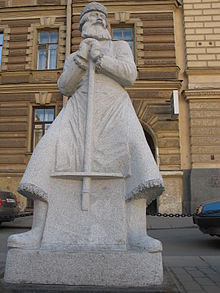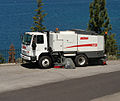- Street sweeper
-
A street sweeper or street cleaner can refer to a person's occupation or a machine that cleans streets, usually in an urban area.
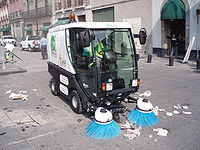 A compact street sweeper tackles litter in Mexico City
A compact street sweeper tackles litter in Mexico City
Contents
History of street sweeping in the United States
The very first street sweeping machine was patented in 1849 by its inventor C.S. Bishop. For a long time street sweepers were just rotating disks covered with wire bristles. These rotating disks served as mechanical brooms that swept the dirt on the streets. [1]
(Source of Historic Information, The Sweep of Time by William A. Richman Copyright, William A. Richman, 1962) (Information taken from published book)
His name was Murphy. Getting bald. Mustache, Glasses. Talked little, thought much.
With an idea and a roll of blue prints under his arm, he called at the offices of American Tower and Tank Company in Elgin, IL in the fall of 1911. It wasn’t the first call he had made in an attempt to get somebody to adopt his brain-child. The idea of a motor driven pickup street sweeper. He had been rebuffed by the manufacturers he had approached. The American Tower and Tank Company had been formed in 1903 by Charles A. Whiting and James Todd. These men did not turn Murphy down. Instead they called in a recently acquired silent partner, Daniel M. Todd, and it was decided to hire Mr. Murphy and begin the development of his idea which at that time was only in the recesses of his brain and on a few blue prints which he had drawn up.
Mr. D. M. Todd became an active partner and took the project under his win, and there was started what has become the Elgin Sweeper Company.
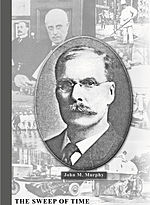
The first Elgin motor street sweeper was not produced in an overnight burst of inspiration. There were still many engineering details to be worked out, improvements to be made when the design on paper was actually formed in to metal. The first conception specified squeegee slat conveyor. This was subject to criticism by the company’s engineers. Research was undertaken to produce a different means of conveying dirt from the broom to the dirt box with the result that a belt conveyor was made a part of the machine in 1917. After two years of trial, development, experimentation, and research, there was achieved the sweeper that Murphy was satisfied performed all of the sweeping functions in the manner he had envisions – one which partners James and Daniel M. Todd and Charles A. Whiting were willing to risk a reputation gained from 30 years manufacturing experience.

Still a most important assignment lay ahead of Daniel M. Todd – finding a willing customer. Solicitations by letter were ventured in the fall of 1913, and responsive inquiry from the City of Boise, Idaho resulted in the first sale of an Elgin Sweeper, following a demonstration. The record does not establish that Boise at this period had other than ordinary street sanitation problems. It can be firmly established, though, that Boise did have a Street Commissioner, Thomas Finegan, possessing the venturesome curiosity of a pioneer. He reasoned that if the Elgin performed their claims reasonably well, not only could the Boise streets be well cleaned and maintained in a sanitary condition but that considerable savings would be shown to the tax payers as well. The first Elgin was accepted by Boise, Idaho in April 1914. By the end of October 1914 Mr. Finegan was able to compile “Comparative Cost of Sweeping Pavement by Horse-Drawn Sweepers and by Motor Sweepers” – Thomas Finegan, Street Commissioner, Boise City, Idaho. The comparison showed a savings of $2,716.77 from the Elgin motorized sweeper when used rather than a horse-drawn sweeper.
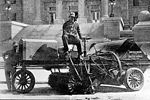
Following its introduction and initial sales, John M. Murphy continued the perfection of his sweeper. In 1917, patents were filed and issues for J. M. Murphy, Street Sweeping machine #1,239,293 and history was made. 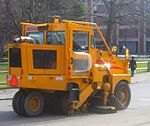
Urban job
Street sweepers have been employed in cities since sanitation and waste removal became a priority. A street-sweeping person would use a broom and shovel to clean off litter, animal waste and filth that accumulated on streets. Later water hoses were used to wash the streets.
History
By the 1840s Manchester England, became known as the first industrial city. Manchester was home to the first passenger rail service in the world and had one of the largest textile industries of that time.[2] As a result, the robust metropolitan, was said to be England’s unhealthiest place to live.[3] In response to this unsanitary environment Joseph Whitworth invented the mechanical street sweeper.[4] The street sweeper was designed with the primary objective to remove trash from streets in order to maintain aesthetic goals and safety.[5][6]
Those goals did not change until the 1970s when policymakers begun to reflect concern for water quality. The lag time in which street sweepers responded can be pinpointed to the Runoff Report of 1998.[7] As older street sweepers were only effective in removing large particles of road debris, small particles of debris remained behind in large quantities.[8] The remaining debris was not seen as an aesthetic issue because rain would wash them away. Today small particles are known to carry a substantial portion of the stormwater pollutant load.
Technological advancement
Newer street sweepers are capable of collecting small particles of debris.[9] Many street sweepers produced today are PM10 certified,[10] meaning that they are capable of collecting and holding particulate matter sized less than 10μm.[11] Despite advancements in street sweeping technology, the mechanical broom type street sweeper accounts for approximately 90 percent of all street sweepers used in the United States today.[12]
Street sweepers as a mitigation method of stormwater runoff
Street sweeping can be an effective measure in reducing pollutants in stormwater runoff.[13] The Environmental Protection Agency considers street sweeping a Best Management Practice in protecting water quality.
Modern sweepers
Modern street sweepers are equipped with water tanks and sprayers used to loosen particles and reduce dust. The brooms gather debris into a main collection area from which it is vacuumed and pumped into a collection bin or hopper.
A regenerative air street sweeper uses forced air to create a swirling effect inside a contained sweeping head and then uses the negative pressure on the suction side to place the road debris inside a hopper. Debris is removed from the air by centrifugal separation and reused, keeping particulate matter inside the hopper. Many regenerative air sweepers are AQMD certified by the company who manufactures them and can pick up particles as small as 10 micrometres or less (PM-10), a leading cause of stormwater pollution.
-
Vegetable oil (Pflanzenöl) powered vacuum cleaner truck (Laubsauger - "leaf sucker"), Aachen, Germany
-
A Canadian "Madvac" compact streetsweeper in Mexico City Paseo de la Reforma
-
An Italian "Dulevo" street sweeper in Saint Peter's Square
-
Single-engine Scarab Sweepers street sweeper in the pictured at the Dubai Autodrome, November 2006
See also
References
- ^ http://www.articlesinsight.com/Art/5752/191/The-many-Different-Sweepers-And-Machines-Used-In-Street-Sweeping.html
- ^ Manchester
- ^ http://www.macalester.edu/courses/geog61/manchester/history.htm[dead link]
- ^ Joseph Whitworth
- ^ Pitt R, Bannerman R, Sutherland R, 2004. The role of street cleaning in stormwater management, Environmental and Water Resources Institute of the American Society of Civil Engineers. 1-8
- ^ Chang Y, Chou C, Su K, Tseng C, 2004. Effectiveness of street sweeping and washing for controlling ambient TSP, Atmospheric Environment, 39: 1891–1902
- ^ http://www.epa.gov/npdes/pubs/sw_nurp_vol_1_finalreport.pdf
- ^ German J, Svensson G, 2002. Metal content and particle size distribution of street sediments and street sweeping waste. Water Science and Technology. 46: (6-7) 191-198
- ^ Pitt, 2004
- ^ Chang, 2004
- ^ MAG:: Home Page
- ^ Wildlife and Habitat | Ecosystems | Environmental Review Toolkit | FHWA
- ^ EPA - Stormwater Menu of BMPs
External links
- http://www.johnstonsweepers.com/johnston-sweepers/history-1904-1949.php
- http://www.johnstonsweepers.com/johnston-sweepers/history-1904-1949.php
- http://www.johnstonsweepers.com/product-range/
- "Man And His Machines: Motor-Cycle Street Sweeper". The World's Work: A History of Our Time XXXI: 694. April 1916. http://books.google.com/?id=09_Sr9emceQC&pg=PA694. Retrieved 2009-08-04.
- http://www.epa.gov/npdes/pubs/sw_nurp_vol_1_finalreport.pdf
- http://www.mag.maricopa.gov/pdf/cms.resource/TIP_2008_CMAQ-Methodology-for-PM10-Street-Sweepers17106.pdf
- http://www.fhwa.dot.gov/environment/ultraurb/3fs16.htm
- http://sanfranciscostreetcleaning.com/
Topics related to waste management Anaerobic digestion · Composting · Downcycling · Eco-industrial park · Incineration · Landfill · Materials recovery facility · Mechanical biological treatment · PullApart · Radioactive waste · High-level radioactive waste management · Recycling · Regift · Reuse · Septic tank · Sewerage · Sewage regulation and administration · Upcycling · Waste · Waste collection · Waste hierarchy · Waste legislation · Waste management · Waste management concepts · Waste sorting · Waste treatmentCategories:- Cleaning and maintenance occupations
- Waste collection
- Waste collection vehicles
- Street culture
Wikimedia Foundation. 2010.

